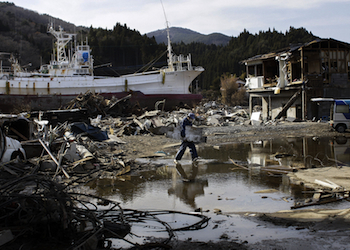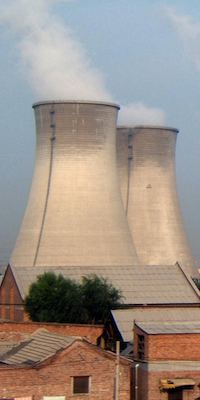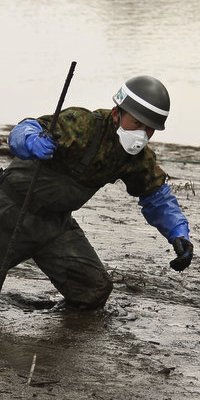
 The Fukushima nuclear reactors damaged by the Japanese earthquake and tsunami have rightly garnered concern, but other pollution sources have been overlooked.
The Fukushima nuclear reactors damaged by the Japanese earthquake and tsunami have rightly garnered concern, but other pollution sources have been overlooked.
So two reporters, one based in Japan, the other in the United States, teamed up to uncover evidence of chemical contamination from other industrial facilities damaged in the disasters. Their piece appeared in Environmental Health Perspectives.
In June, Japan's environment ministry began testing the water, air, and soil in the disaster area for chemical contamination. The results of those tests are starting to dribble out now, and so far they've turned up a few instances where levels of boron, arsenic, and fluorine in rivers exceed government standards. I'll be keeping an eye on those tests, but searching for chemical contaminants along hundreds of kilometers of devastated coastline is like looking for a needle in a haystack: no news doesn't necessarily mean good news.
Nondisclosure: Japan has many exceptions to reporting requirements for toxic chemical use. For example, factories that have 20 or fewer employees are not required to tell the public what toxic chemicals they are using. When a tsunami or flood hits, tracking down that information is crucial and incredibly difficult.
Lost in translation: Even in Japan, these issues have been completely buried by the chaos of the relief effort and the Fukushima nuclear disaster.
Read more about this topic
After the March 11 Japan earthquake and tsunami, it wasn't just nuclear reactors that broke down: oil refineries burst into flames, sewer and gas lines burst, old electrical equipment containing polychlorinated biphenyls (PCBs) washed away. Petro- and agrochemical plants; iron foundries; steel works; and automotive, electronics, food processing, paper, plastics, and pharmaceutical plants all suffered damage. Data available through Japan’s Pollutant Release and Transfer Register indicates that more than 15 toxic chemicals are present in the impacted area, including benzene, mercury, lead, cadmium, asbestos, and formaldehyde.
Obstacles: Despite well-documented emergency management plans, it was extremely difficult to obtain detailed information about which hazardous materials were located at individual companies' facilities and real-time details about what damage they had suffered in the earthquake and tsunami.
I'll be watching ... to see if any changes are made to hazardous material reporting requirements in Japan or the United States. In both countries, there are numerous exceptions to required reporting on hazardous and toxic materials storage.
Read more about this topic
| Tweet This Page |










